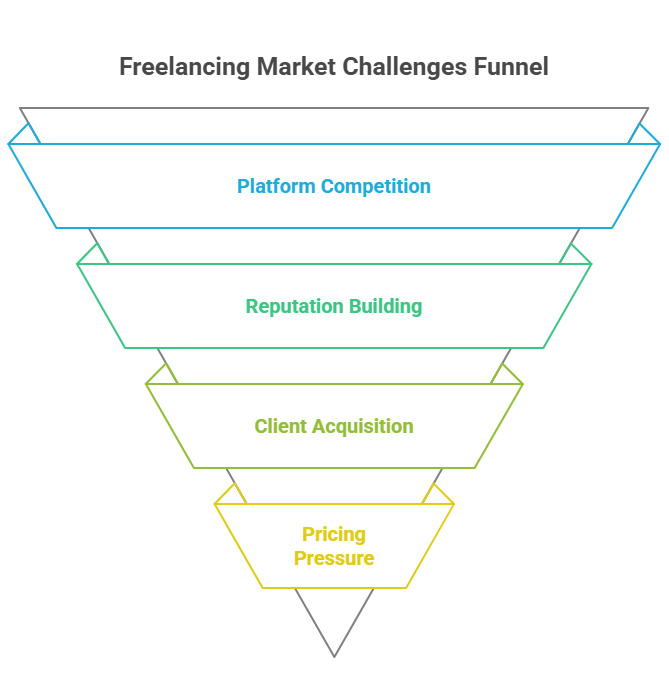Freelancing has become increasingly competitive, with platforms like Upwork and Fiverr saturated with skilled professionals vying for attention. Waiting for clients to discover your profile often leads to frustration, prolonged downtime, and missed opportunities. In such a crowded marketplace, relying solely on inbound inquiries is not the most effective way to grow your business.
Proactive outreach has emerged as a superior approach, allowing you to target specific businesses and connect with decision-makers directly. This strategy not only puts you in control of your client acquisition process but also reduces reliance on highly competitive platforms. Tools like RocketReach make this process seamless by providing reliable and verified contact details for professionals across industries, enabling you to approach the right people with precision and confidence.
I. Why the Freelancing Market Feels Saturated
1. Increasing Competition on Popular Platforms
Freelancing platforms like Upwork and Fiverr have grown significantly, attracting millions of freelancers worldwide. While this growth provides opportunities, it also leads to intense competition. Many professionals, from beginners to experienced freelancers, rely on these platforms to find clients. As a result, standing out among countless profiles requires substantial effort, often involving lowering rates or investing heavily in marketing.
2. Time-Consuming Process to Gain Traction
Building a reputation on freelancing platforms is a gradual process that demands consistent effort and patience. Most clients prefer hiring individuals with strong reviews and completed projects, making it challenging for newcomers to secure their first few jobs. This creates a bottleneck where many freelancers spend months struggling to gain visibility and credibility.
3. Limited Control Over Client Acquisition
On these platforms, freelancers must wait for clients to notice their proposals or profiles. This reactive approach puts freelancers at the mercy of an algorithm and client preferences. It also reduces the ability to target ideal clients, as the work offered may not align perfectly with the freelancer’s skills or goals.
4. Race to the Bottom on Pricing
With such a large pool of freelancers, pricing becomes a major point of contention. Many professionals feel pressured to lower their rates to compete, which can undermine the value of their skills and lead to unsustainable workloads.

Also Read: 8 High-Paying Low Competition Freelance Skills for 2025
II. Proactive Outreach as a Game-Changer
1. Shifting the Focus to High-Quality Leads
Proactive outreach allows freelancers to identify and connect directly with businesses that align with their expertise. This shifts the focus from competing on crowded platforms to targeting potential clients who value specific skills and services. It also enables freelancers to position themselves as problem-solvers rather than one of many options in a marketplace.
2. Building Personalized Connections
Through outreach, freelancers have the opportunity to tailor their approach to the specific needs of each client. This personalization enhances the chances of securing meaningful work relationships, as businesses are more likely to respond to professionals who demonstrate an understanding of their challenges and goals.
3. Accelerating the Client Acquisition Process
Rather than waiting for clients to find them, freelancers can actively build their pipelines by reaching out to decision-makers. This proactive approach minimizes the delays associated with traditional freelancing platforms and can result in quicker engagements.
4. Taking Ownership of Business Growth
Direct outreach puts control back in the hands of freelancers. They can select industries, company sizes, and decision-makers that match their professional objectives. This approach not only increases the chances of landing high-quality clients but also empowers freelancers to focus on their niche, where their expertise can shine.
5. A Scalable and Sustainable Strategy
Proactive outreach is a strategy that grows with the freelancer. As skills and experience expand, outreach can be refined to target larger businesses or more complex projects. Over time, this approach establishes a steady stream of clients while building a professional network that supports long-term success.
III. Using RocketReach to Find Accurate Leads’ Contact Information
Finding accurate contact information for potential clients is essential for successful outreach. RocketReach is a dominant tool that simplifies this process, offering verified lead data to help freelancers connect with decision-makers efficiently. With its focus on reliability and usability, RocketReach enables you to streamline your client acquisition efforts in a competitive market.
1. Why RocketReach Stands Out
One of the main challenges in outreach is ensuring that the contact information you use is correct and up-to-date. RocketReach addresses this by providing an extensive database of verified leads, reducing the chances of bounced emails or unresponsive connections. Its platform includes:
- Access to Verified Emails and Phone Numbers: Ensuring freelancers can confidently reach out to the right individuals.
- Search by Job Title, Industry, and Company: Allowing precise targeting based on your expertise and niche.
- Integration with LinkedIn Profiles: Making it easier to research leads and tailor outreach messages.
- 5 Free Credits for New Users: A perfect starting point for freelancers to explore the platform without commitment.
RocketReach’s combination of advanced filtering options and reliable data gives freelancers the tools needed to focus on building meaningful relationships instead of wasting time on incorrect or irrelevant leads.
2. How to Use RocketReach to Find Leads
- Create a Free Account
- Start by signing up on the RocketReach platform to access the 5 free credits available for new users. This allows you to search for and retrieve contact information for up to five leads, giving you a no-cost opportunity to try the platform.
- Start by signing up on the RocketReach platform to access the 5 free credits available for new users. This allows you to search for and retrieve contact information for up to five leads, giving you a no-cost opportunity to try the platform.
- Search for Specific Contacts
- Use RocketReach’s search filters to narrow down your results by job title, industry, or company. For example, you can search for “Marketing Managers in Tech Companies” or “CEOs in E-commerce.”
- Use RocketReach’s search filters to narrow down your results by job title, industry, or company. For example, you can search for “Marketing Managers in Tech Companies” or “CEOs in E-commerce.”
- Analyze the Lead Profiles
- Once you identify potential leads, review their profiles to confirm their relevance. RocketReach provides details such as job role, company, and professional background, ensuring you’re targeting the right individuals.
- Once you identify potential leads, review their profiles to confirm their relevance. RocketReach provides details such as job role, company, and professional background, ensuring you’re targeting the right individuals.
- Retrieve Contact Information
- Use your free credits to access verified email addresses and phone numbers. This information can be seamlessly integrated into your outreach strategy, ensuring your messages reach decision-makers directly.
- Use your free credits to access verified email addresses and phone numbers. This information can be seamlessly integrated into your outreach strategy, ensuring your messages reach decision-makers directly.
- Maintain a Professional and Respectful Approach
- Always approach contacts professionally, keeping your emails concise, personalized, and relevant to their business needs. RocketReach ensures that your outreach efforts are supported by accurate data, increasing the likelihood of meaningful responses.
- Always approach contacts professionally, keeping your emails concise, personalized, and relevant to their business needs. RocketReach ensures that your outreach efforts are supported by accurate data, increasing the likelihood of meaningful responses.
IV. Building a Sustainable Outreach Strategy
Creating a sustainable outreach strategy ensures freelancers can consistently generate leads and build long-term professional relationships. This involves careful planning, regular effort, and continuous improvement.
1. Define Your Target Audience
To maximize effectiveness, start by identifying the specific industries, company sizes, and roles that align with your expertise. Consider:
- The type of clients who would benefit most from your services.
- Industries or sectors where your skills are in high demand.
- Decision-makers, such as hiring managers or department heads, who have authority to engage freelancers.
Having a clearly defined target audience allows you to focus your efforts and create outreach messages that resonate.
2. Set Realistic Goals and KPIs
Establish measurable goals to evaluate the success of your outreach strategy. These can include:
- The number of businesses to contact weekly.
- The response rate from initial emails.
- The number of calls or meetings scheduled.
- The percentage of leads converted into clients.
Track these metrics to identify areas for improvement and refine your approach over time.
3. Leverage the Right Tools for Efficiency
Use tools like Rocketreach to streamline your research and access accurate contact information. Combine it with email marketing platforms or CRM tools to organize your outreach efforts. Benefits include:
- Automated follow-ups to save time.
- Insights into which emails are being opened and read.
- Centralized tracking of all communication with prospects.
These tools help maintain a steady workflow, ensuring no lead falls through the cracks.
4. Create a Consistent Outreach Schedule
Consistency is essential for maintaining momentum in outreach. Dedicate time each week to:
- Research new prospects.
- Personalize your messages.
- Follow up with leads who haven’t responded.
A regular schedule ensures that outreach becomes a part of your routine, leading to continuous opportunities for client acquisition.
5. Refine Messaging Through Testing
Evaluate the effectiveness of your outreach emails by testing variations in:
- Subject lines.
- Value propositions.
- Calls to action.
Analyze responses to identify what resonates most with your audience and adjust accordingly. This iterative process enhances your outreach strategy over time.
6. Nurture Relationships Beyond Initial Outreach
Even if a prospect does not immediately require your services, maintain a connection through occasional follow-ups or sharing valuable content. This approach keeps you on their radar for future opportunities and helps build a strong professional network.
V. Crafting a Winning Email Sequence
Crafting a professional and effective email sequence is a crucial step in securing responses from potential clients. By creating emails that are clear, concise, and tailored to the recipient, freelancers can significantly improve their chances of receiving positive replies. Below is a detailed step-by-step guide to creating an email sequence that resonates with decision-makers and leads to meaningful engagements.
1. Research the Recipient Before Writing
The foundation of an effective email sequence is understanding the person you’re contacting. Use tools like Rocketreach to gather accurate information about their role, company, and industry. Look for additional insights on platforms like LinkedIn or company websites. This research ensures your emails are relevant and show genuine interest in their needs.
2. Structure the First Email for Impact
The first email is your introduction and sets the tone for the entire communication.
- Subject Line: Keep it brief, professional, and relevant to their interests. Example: “Supporting Your [Specific Goal or Industry Need] with [Your Expertise].”
- Greeting: Address the recipient by name to establish a personal connection.
- Introduction: Provide a concise introduction, including your name, your role, and a brief mention of your expertise.
- Value Proposition: Highlight how your skills or services can solve a specific problem or contribute to their goals. Keep this section short but impactful.
- Call to Action (CTA): End with a clear, actionable request, such as scheduling a brief call or discussing their needs further. Example: “Would you be available for a quick 15-minute call next week to explore how I can assist with [specific need]?”
- Closing: Use a professional sign-off, including your name and contact information.
3. Follow-Up Email #1: Reinforce Your Value
If there is no response to your initial email within 3-5 business days, send a follow-up email that adds value rather than repeating your original message.
- Subject Line: Keep it polite and professional, such as “Following Up on [Topic].”
- Acknowledgment: Briefly mention your previous email and that you understand they may have been busy.
- Additional Value: Share a relevant insight, statistic, or a quick example of how you’ve helped similar businesses achieve results.
- Restate Your Offer: Remind them of your value proposition and how you can address their specific challenges or goals.
- Revised CTA: Provide a slightly different call to action, such as suggesting a specific time for a call or inviting them to reply with their availability.
4. Follow-Up Email #2: Final Reminder
If there is no response after the second email, send a final reminder email within 5-7 business days.
- Subject Line: Keep it respectful and professional, such as “Final Follow-Up Regarding [Topic].”
- Acknowledgment: Acknowledge your previous attempts and that this will be your last follow-up to avoid further interruptions.
- Reiterate Value: Briefly summarize your expertise and the benefit they can gain by collaborating with you.
- Gratitude: Thank them for their time and consideration, whether or not they choose to respond.
- Final CTA: Leave a clear and open-ended call to action, such as “If you feel I can support your team in [specific way], please don’t hesitate to reach out.”
5. Tips for Optimizing the Email Sequence
- Keep It Concise: Ensure each email is no longer than a few short paragraphs. Decision-makers often skim emails, so clarity is key.
- Avoid Generic Phrasing: Tailor each email to the recipient’s role, industry, and challenges to show you’ve done your research.
- Use Professional Language: Maintain a tone that is courteous, confident, and free of slang.
- Leverage Data: Where possible, include quantifiable results you’ve achieved in similar roles or industries to build credibility.
- Include a Signature: Add a professional signature with your full name, title, contact information, and LinkedIn profile link.
- Proofread Carefully: Ensure there are no typos, grammatical errors, or formatting issues.

Also Read: Is Everyone Successful Except You? Here’s How To Stop Feeling Like a Loser
VI. Addressing Concerns About Cold Outreach
Cold outreach is often misunderstood as impersonal or intrusive. Addressing common concerns can help freelancers approach it confidently and effectively.
1. Perceived Intrusiveness
Many freelancers worry that reaching out to strangers may come across as unwelcome. To address this:
- Personalize Every Message: Show genuine interest in the recipient’s company or role. Tailored emails are less likely to be dismissed as spam.
- Focus on Adding Value: Highlight how your services align with their needs or solve a specific challenge.
- Respect Their Time: Keep messages concise and to the point. Avoid sending multiple emails in quick succession.
2. Low Response Rates
Not every cold outreach email will receive a response. To improve success rates:
- Research Thoroughly: Target individuals who are most likely to require your services.
- Refine Your Approach: Use feedback from responses (or lack thereof) to adjust your messaging or targeting.
- Maintain Realistic Expectations: Understand that even a small percentage of positive replies can lead to valuable opportunities.
3. Negative Reactions from Recipients
Some freelancers fear criticism or negative responses. Minimize this risk by:
- Remaining Professional: Use polite and respectful language in all communications.
- Avoiding Over-Persistence: Limit follow-ups to two or three attempts unless explicitly encouraged to continue.
- Learning from Feedback: If a recipient provides constructive criticism, use it to improve future outreach efforts.
4. Lack of Confidence in Cold Outreach Effectiveness
Some freelancers question whether cold outreach is worth the effort. Address this concern by:
- Tracking Success Metrics: Monitor response rates, meeting conversions, and client acquisition to measure effectiveness.
- Focusing on Quality Over Quantity: Target well-researched prospects rather than sending generic messages to a large audience.
- Viewing It as a Learning Process: Each outreach attempt provides valuable insights that can improve your approach over time.
Proactively reaching out to businesses can set you apart and open doors to opportunities that might otherwise remain inaccessible. By combining precision tools with a well-structured outreach strategy, you can establish meaningful connections, demonstrate your value, and build lasting professional relationships. Focus on delivering genuine solutions and maintaining consistent communication, and you’ll create a foundation for sustainable success.



